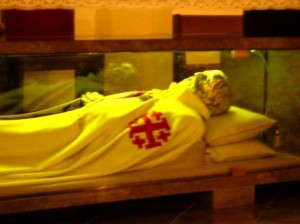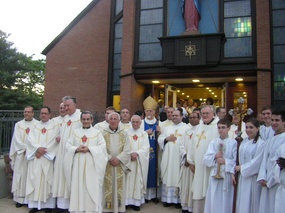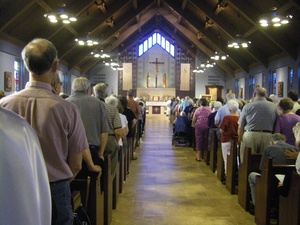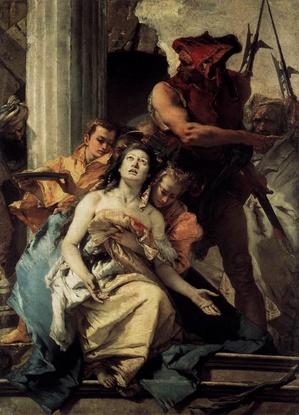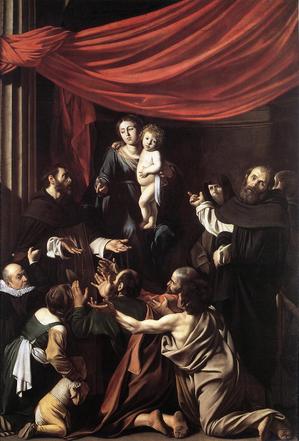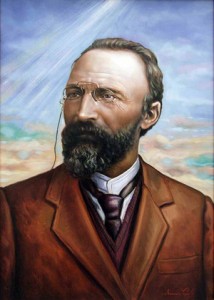 There is a marvelous figure of holiness inscribed on the calendar today: Blessed Bartolo Longo, the great Apostle of the Rosary and the founder of the shrine of the Madonna of the Rosary at Pompei in Italy. Born in 1841, Blessed Longo died in 1926. He was a contemporary of Saint Faustina. Pope John Paul II beatified him in 1980. Several times in his pontificate, Saint John Paul II called our attention to the example of this holy layman, calling him “l’uomo della Madonna,” Our Lady’s man.
There is a marvelous figure of holiness inscribed on the calendar today: Blessed Bartolo Longo, the great Apostle of the Rosary and the founder of the shrine of the Madonna of the Rosary at Pompei in Italy. Born in 1841, Blessed Longo died in 1926. He was a contemporary of Saint Faustina. Pope John Paul II beatified him in 1980. Several times in his pontificate, Saint John Paul II called our attention to the example of this holy layman, calling him “l’uomo della Madonna,” Our Lady’s man.
Divine Mercy Displayed
Blessed Bartolo Longo’s story is a dramatic illustration of Divine Mercy. The mystery of Mercy announced by Saint Faustina played itself out in the life of Blessed Longo. As a young man, following studies in Law, Bartolo Longo abandoned his faith and allowed himself to be drawn into paths of great spiritual darkness. He practiced spiritism, found himself entrenched in the occult, and became a practicing Satanist. Longo went so far as to have himself ordained a priest of Satan. He very nearly lost his sanity, becoming a mere shadow of himself.
Spiritually Sick
In one particular séance Longo was distressed to see the face of the deceased king of Naples and the Two Sicilies: Ferdinand II. That same night he saw the soul of his mother circling his bed, begging him to return to the Catholic faith. His practice of the occult had so affected him that he was barely recognizable to those who once knew him as a handsome young man, full of vitality and promise. A Catholic friend, seeing him in such a pitiful spiritual, psychological, and physical state, begged him to at least meet with Father Radente, a wise Dominican priest. After some time, Longo made a thorough confession and, under the direction of this priest, began the reform of his life. He entered the Third Order of Saint Dominic, receiving the name, Brother Rosario.
Conversion and Healing
Bartolo’s Dominican spiritual father told him that the Mother of God promised that anyone who promoted her Rosary would assuredly be saved. The rest of Blessed Barolo’s life was dedicated to the Most Holy Rosary. The Rosary was his lifeline. The Rosary was the anchor of his salvation. The Rosary was the means by which the Holy Mother of God brought him back from hell. It was through the prayer of the Rosary that the Blessed Virgin healed his soul, restored him to health, and entrusted him with a mission. Later Blessed Bartolo wrote, “What is my vocation? To write about Mary, to have Mary praised, to have Mary loved.”
Rosary Apostolate
Blessed Longo reached out to the desperately poor, ignorant, and needy people of the town of Pompei. He taught them to pray the Rosary. The Rosary did for that entire town what it had done for him in his personal life; it brought healing, refreshment, holiness, joy, and peace. With the help of the Countess Mariana de Fusco whom he later married on the advice of Pope Leo XIII, while preserving with her his vow of chastity, Bartolo Longo undertook the construction of the church of the Madonna of the Rosary of Pompei. The city that grew up around it became the City of the Rosary.
He founded a congregation of Dominican Sisters to care for the poor. He established a school for boys. He wrote tirelessly in the service of Madonna and of her Rosary. His beautiful supplication to the Madonna of the Rosary has been translated into countless languages. Pope John Paul II prayed it when, on October 7, 2003, he visited Pompei to conclude the Year of the Rosary. In Italy, every year on the first Sunday of October, everything comes to a halt at noon while people, young and old, poor and rich, healthy and sick, pause to pray Blessed Longo’s supplication to the Virgin of the Rosary.
Divine Mercy Available to All
Saint Faustina made known the mystery of Divine Mercy. Blessed Bartolo Longo experienced Divine Mercy in a dramatic and deeply personal way. The same Divine Mercy is available to us: the mercy that brings back from hell, the mercy that raises the soul from spiritual death, the mercy that heals, restores, forgives, and repairs the past.
The Divine Mercy comes to us through the intercession of the Mother of God and, most efficaciously, through the humble prayer of the Rosary. It comes to us in the Sacrament of Penance: the mystery of the blood and the water from the side of Christ washing over the soul. And the Divine Mercy comes to us in the mystery of the Eucharist. The Mass is the real presence of Crucified Love. The Holy Sacrifice of the Mass is Divine Mercy flowing from the Heart of the Lamb, making saints out of sinners.
Father Mark Daniel Kirby, OSB
Silverstream Priory
